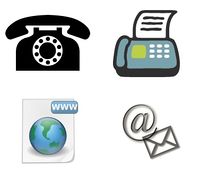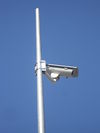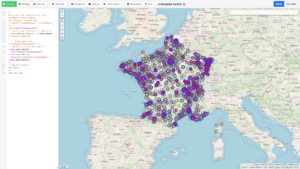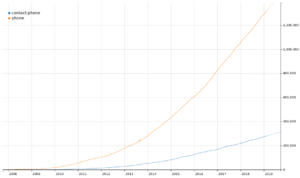Key:contact:*
 |
| Description |
|---|
| The contact:* keys describe contact information. |
| Group: annotations |
| Used on these elements |
| See also |
| Status: in use |
| taginfo: contact:* |
The prefix for several contact:*=* keys to describe contact information.
Values
You should only add contact information to POIs and not to any private address!
Email-addresses which are only available on a website after solving a captcha, or which are in other ways obfuscated to protect against SPAM-bots should not be tagged in OSM. The same applies to fax and phone numbers.
What is used here: phone and fax number format (![]() DIN 5008): +<country_code> <national_destination_code> <subscriber_number>-<direct_inward_dialing>
DIN 5008): +<country_code> <national_destination_code> <subscriber_number>-<direct_inward_dialing>
Contact
| Key | Value | Element | Comment | Taginfo | Photo | |
|---|---|---|---|---|---|---|
Contact details | ||||||
| contact:phone | +44 11223 456-789 | Telephone number (phone=*.)
|
||||
| contact:website | http://example.com | Website-url (see also the more popular website=* and website:*=*)
|

| |||
| contact:email | mail@example.com | E-mail address (see also the more popular email=*)
|

| |||
| contact:fax | +44 11223 456-789 | A dedicated telephone number connecting to a telefacsimile (fax) machine. See also the more popular fax=*).
|

| |||
| contact:mobile | +44 11223 456-789 | A telephone number connecting to a mobile phone. The more general tag contact:phone=* should be preferred.
|

| |||
| contact:tty | +44 11223 456-789 | A dedicated telephone number connecting to a teletypewriter (tty). | ||||
| contact:sms | +44 11223 456-789 | A dedicated telephone number that receives SMS text messages, but does not have voice-calling capability. | ||||
| Key | Value | Element | Comment | Taginfo | Photo | |
Social media, messengers, web services | ||||||
| contact:facebook | full facebook URL or FacebookUserName | Facebook profile - preferably the full URL (because there are many different kinds of pages in facebook), though simply the public username is also used. (see also facebook=*)
|

| |||
| contact:instagram contact:threads |
full Instagram URL or InstagramUserName | Instagram account name (also used on Threads) or full Instagram URL |  
| |||
| contact:vk | VK.com | VK link to social network service | 
| |||
| contact:twitter | OpenStreetMap | Twitter account name or full URL (see also twitter=*)
|

| |||
| contact:youtube | Youtube account/channel URL | YouTube URL of account or channel officially used by the POI. Sometimes only the YouTube username is indicated. | ||||
| contact:ok | ok URL | ok link to social network service. | 
| |||
| contact:linkedin | Username | LinkedIn account name or full URL | ||||
| contact:telegram | https://t.me/Example or Telegram number | Telegram account name or full URL or Telegram number officially used by the POI. | 
| |||
| contact:whatsapp | WhatsApp number | WhatsApp number officially used by the POI. | 
| |||
| contact:webcam | webcam URL | For denoting a webcam's location, use a node with the tag surveillance:type=camera. See also Webcams for more information
|

| |||
| contact:viber | +44 11223 456-789 | Viber account name (phone number) or full URL | 
| |||
| contact:tiktok | Username | TikTok account name or full URL | ||||
| contact:skype | SkypeName | Skype login name | 
| |||
| contact:pinterest | Pinterest URL | Pinterest URL officially used by the POI. | ||||
| contact:foursquare | https://foursquare.com/v/Example | Foursquare account name (hash) or full URL | ||||
| contact:xing | Username | XING account name or full URL | ||||
| contact:mastodon | @username@server.example | Mastodon social network handle or full URL[1] | 
| |||
| contact:bluesky | blueskyUsername.domain.name | Bluesky social network handle or full URL | 
| |||
| contact:line | Line ID | Line ID or URL | 
| |||
| contact:flickr | Flickr URL | Flickr URL. Similar to all others, this is where the POI can be officially contacted, or where they broadcast information. This should not point to a self-taken photo depicting the POI. | ||||
| contact:vhf | VHF Channel or Frequency | Of interest for maritime and airport services | 
| |||
| contact:vimeo | full Vimeo URL or username | Vimeo full URL or account name. | ||||
| contact:wechat | wechat ID | Wechat ID | ||||
| contact:matrix | @username:server.example or #room:server.example | Matrix social network handle | ||||
| contact:sip | sip@example.com | SIP address | ||||
| contact:diaspora | username@server.example | Diaspora social network handle or full URL | ||||
| contact:gnusocial | username@server.example | GNU Social social network handle or full URL | ||||
| contact:xiaohongshu | Xiaohongshu URL | Xiaohongshu social network handle or full URL | ||||
| contact:mobilizon | @username@example.com or https://example.com | Mobilizon social network handle or full URL | ||||
| contact:booking | hotel Id | Booking.com travel agency | ||||
| contact:tripadvisor | YYYYYYY | Tripadvisor | ||||
| contact:user_defined | user defined | All commonly used namespace keys according to Taginfo | ||||
| Key | Value | Element | Comment | Taginfo | Photo | |
Mail address | ||||||
| contact:street | street name | For use when the contact address is not the same as the address of the physical location.
For denoting the street name where a POI is located, see also |
||||
| contact:housenumber | housenumber | For use when the contact address is not the same as the address of the physical location. (Status: "draft" For denoting the housenumber where a POI is located, see also |
||||
| contact:postcode | postcode | For use when the contact address is not the same as the address of the physical location.
For denoting the postcode number where a POI is located, see also |
||||
| contact:city | city name | For use when the contact address is not the same as the address of the physical location.
For denoting the city name where a POI is located, see also |
||||
| contact:country | country | For use when the contact address is not the same as the address of the physical location.
For denoting the country where a POI is located, see also |
||||
| contact:pobox | Post Box Number | Companies and organizations sometimes have a post office box (P.O. Box) to receive mail instead of to their physical address. The value should contain the box number as well as a post office identifier, such as a post code. Note this may be different from addr:postcode=*.
|

| |||
This table is a wiki template with a default description in English. Editable here.

contact: keys on POI addresses in France: nearly 18000 locations listed.Addressing scheme in France
Note that in France (especially), contact:housenumber keys are mostly used on POIs to add their addresses without consideration of whether the physical address is different from the postal address but instead of addr: keys reserved for mapping addresses as unique features.
This usage is relatively widespread, mostly in France (+65000 POI's), it has not yet (2025-02-13) been approved by the community.
More about this practice:
- A draft about this usage called "Schéma de Charlieu" can be found on the OSM wiki.
- cartes.app, Organic Maps or CartoVrac displays POI's
contact:addresses when they exist. - A JOSM user preset called "Charlieu Schema for POI's" exists for easy addition of POI's addresses and other contact information with
contact:prefix keys.
Existing tagging schemes
For the most common keys, the shorter version outside the 'contact' scheme is used more frequently: phone=*, fax=*, email=* and website=*, with other contact tags used rarely outside the namespace scheme. Both schemes have been in use for a long time and still exist in parallel. Many applications are able to use both of them.
At the same time a proposal to deprecate contact:phone=* was not successful - Discussions/tagging/contact:phone or phone. Idea of deprecating either tags without contact: prefix or ones with contact prefix is repeatedly suggested, often triggering huge discussion and ending with conclusion that there is no consensus. Please, read past discussion before starting a new one[2][3][4][5].

phone=* and contact:phone=* indicating ongoing and uninterrupted preference of simple tagging scheme over contact: prefix, see also [6] which is most probably induced by editor presets.There were also attempts to deprecate, mechanically retag or promote either version of many other contact tags[7]
See also
phone=*- A telephone number associated with the objectwebsite=*- Specifying the link to the official website for a featureemail=*- An email address associated with the objecturl=*- Specifying an url related to a featurefax=*- A fax number associated with the object- Bremen Schema - A schema that proposes to add contact information about a POI to the node via using contact:* instead of adding addr:*
- Charlieu Schema - Like the Bremen Schema, quite popular in France and Western Europe.
- Key:operator#Further details - subkeys used to add further detail about the operator
emergency:phone=*- A phone number for emergencies associated with the objectaddr:*=*- addr is the prefix for several addr:* keys to describe addressesobject:*=*- Used to describe the position of man-made features where nothing will be delivered at. Address tagging for those features that shouldn't be tagged with the `addr` prefix
External Links
- OpenLinkMap - A slippy map, making this tag's data available as clickable POIs. (Dead link. Latest archived copy on Web Archive, retrieved on 2024-07-15)
- JOSM preset
- wikipedia:Telephone numbering plan
- wikipedia:List of country calling codes
- wikipedia:E.164 (ITU-T recommendation on how to save phone numbers)
- OmniROM devs will use OSM phone numbers (Dead link. Latest archived copy on Web Archive, retrieved on 2024-07-15)
- OSM Phone Number Validation
References
- ↑ The domain in a Mastodon handle usually matches the domain in the full URL, but some instances use a different domain for the Web application versus their users' handles. [1]
- ↑ https://lists.openstreetmap.org/pipermail/tagging/2019-December/thread.html#49474 - December 2019 thread
- ↑ https://lists.openstreetmap.org/pipermail/tagging/2019-August/thread.html#47668 August 2019 Thread
- ↑ https://lists.openstreetmap.org/pipermail/tagging/2020-May/thread.html#52379 - May 2020 thread, over 50 messages
- ↑ https://lists.openstreetmap.org/pipermail/tagging/2022-January/thread.html#63734 January 2022 thread
- ↑ Contact:website / website / url
- ↑ Proposed features/Social media contact prefix